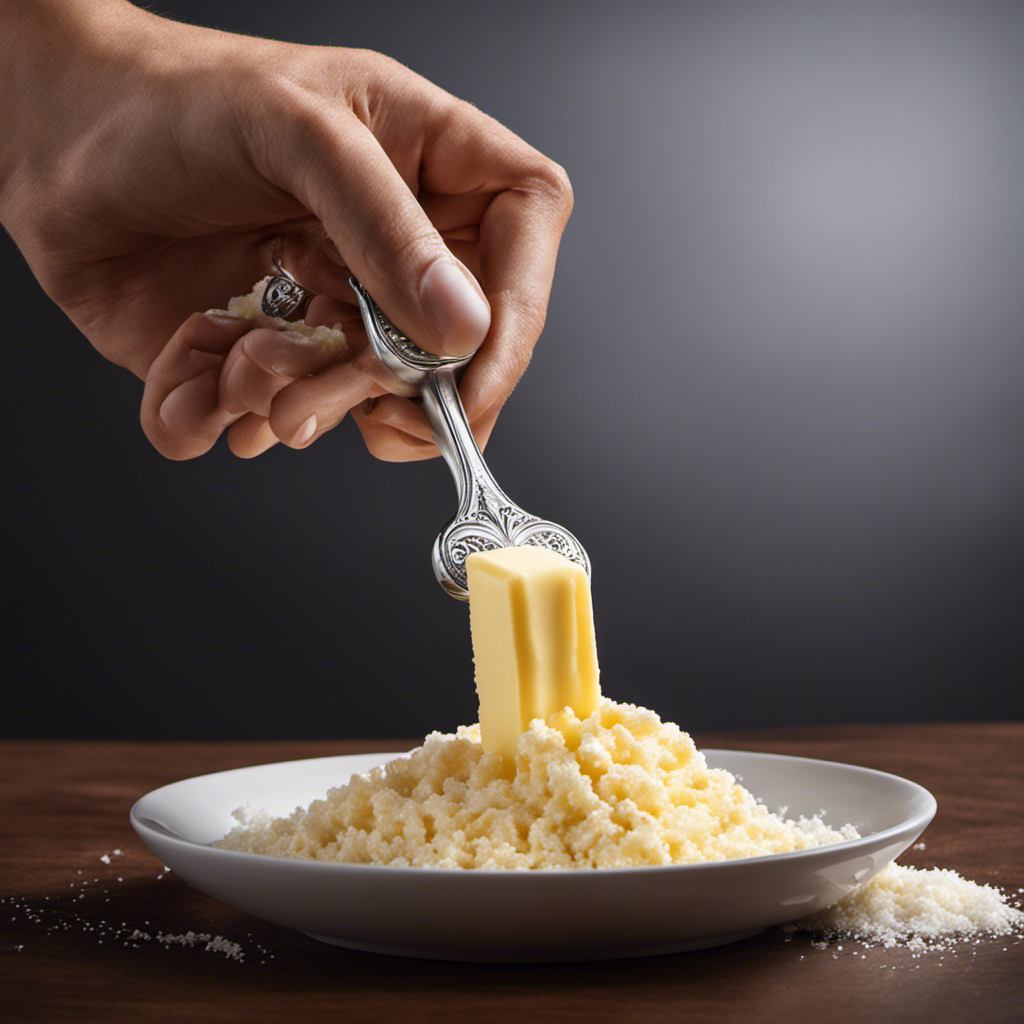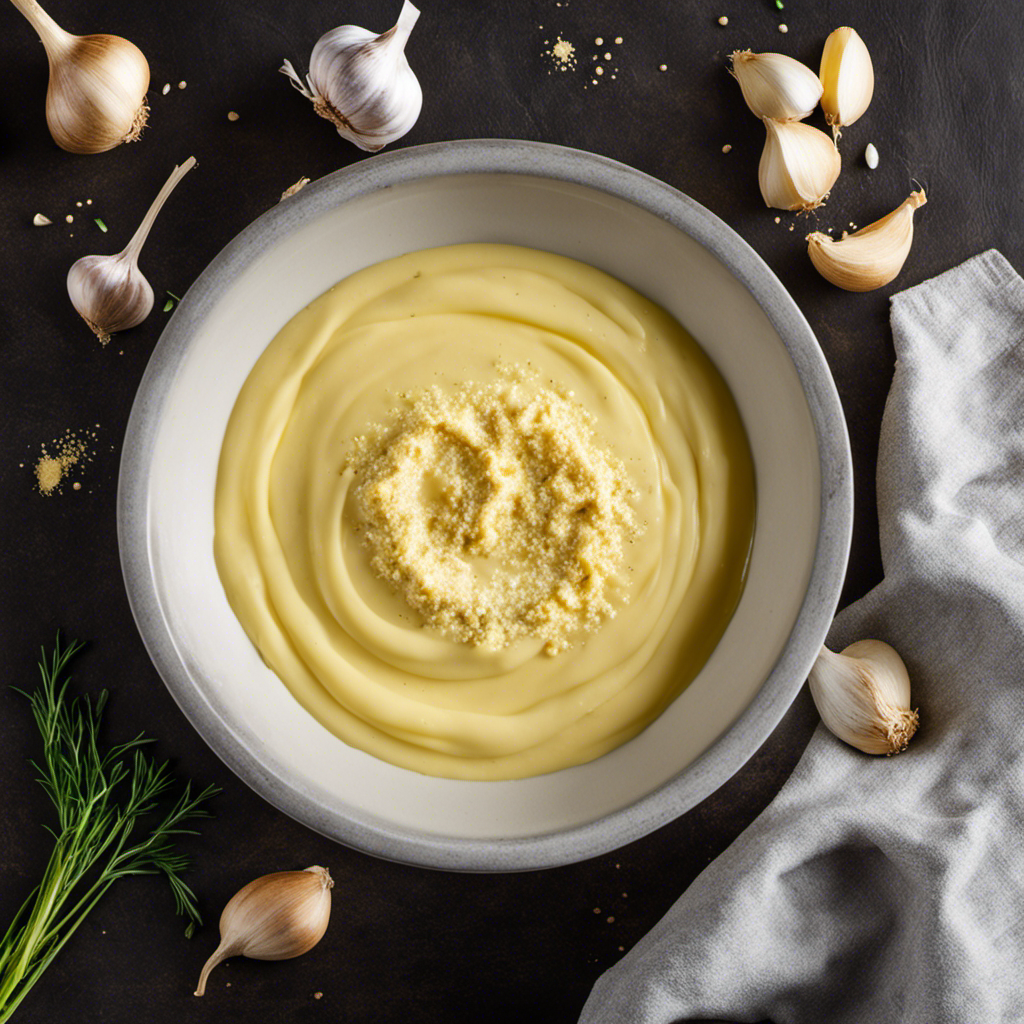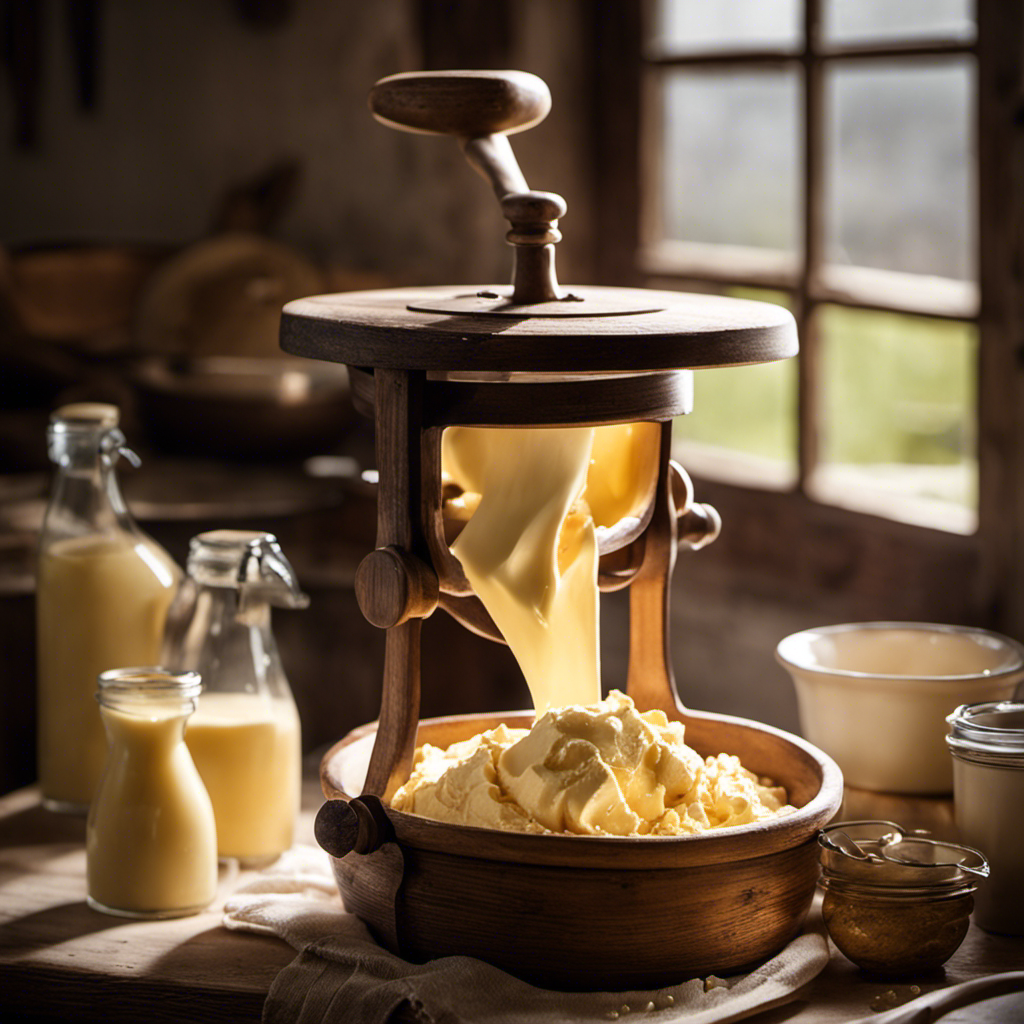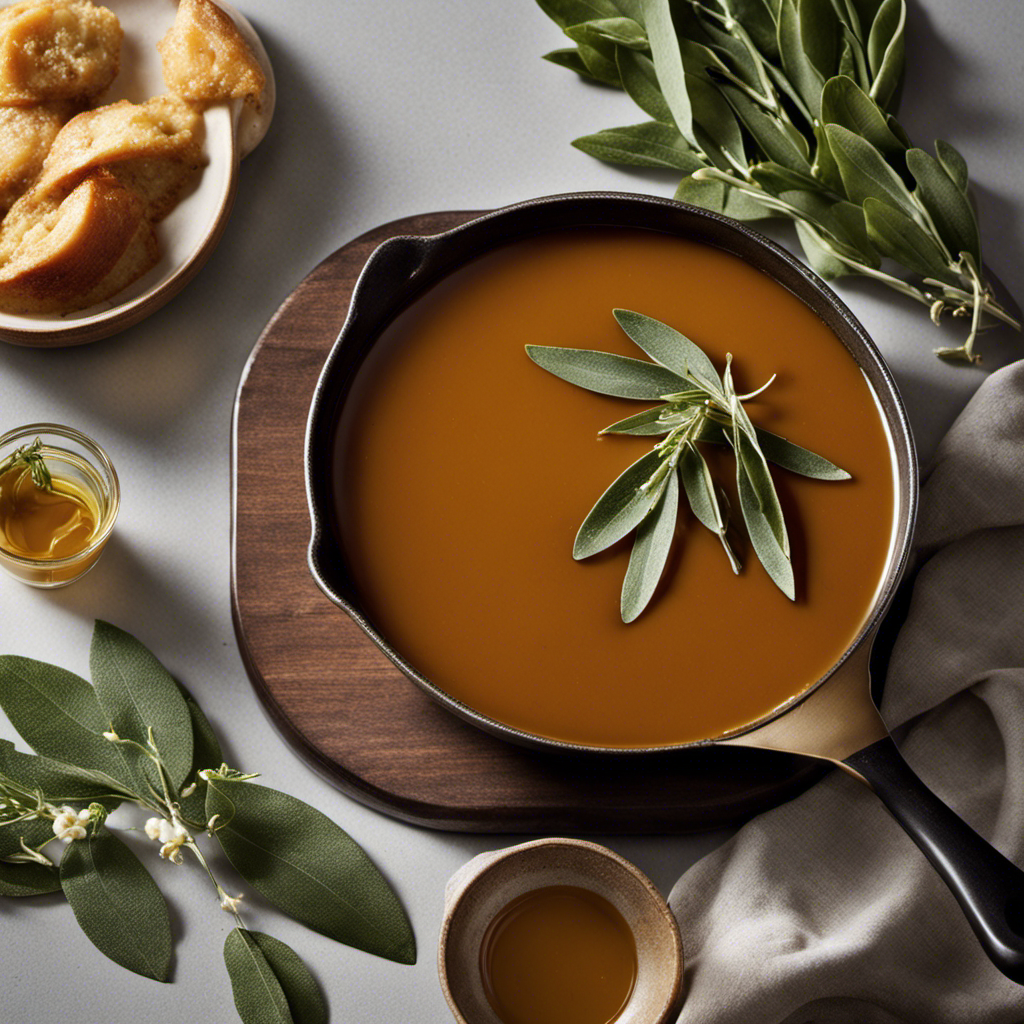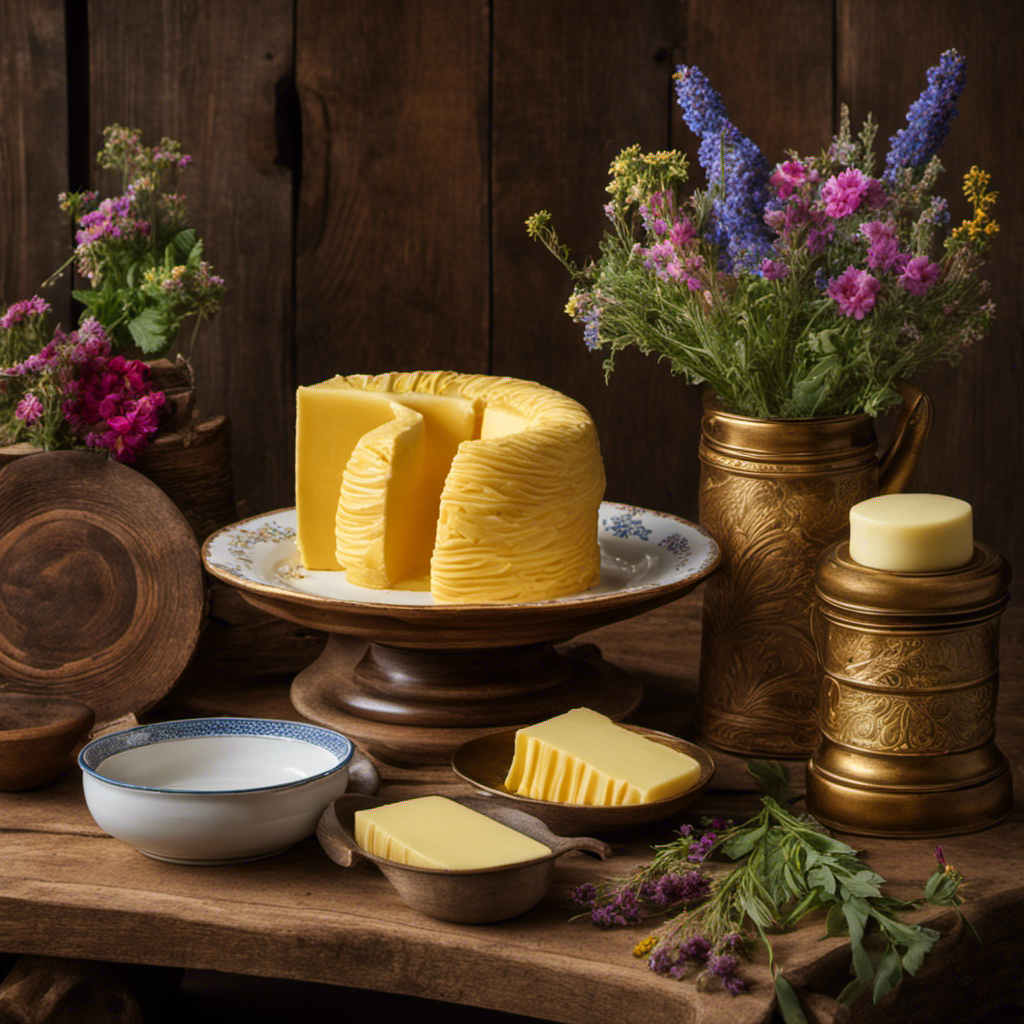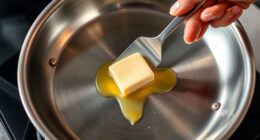Have you ever wondered how much salt to add to unsalted butter? I know I have!
In this article, I will guide you through the importance of salt in butter and provide you with practical tips on how to achieve the perfect salt-to-butter ratio for seasoning.
We will also explore the effects of different salt levels and learn how to balance saltiness and flavor in homemade salted butter.
So, let’s dive in and discover the secrets to enhancing the taste of your butter!
Key Takeaways
- Salt enhances the flavor, richness, and depth of taste in butter.
- The recommended salt-to-butter ratio is around 1/4 teaspoon of salt per 1/2 cup of butter, but it can be adjusted according to personal taste.
- Salt acts as a preservative, extending the shelf life of butter.
- Balancing the saltiness level in recipes is important, and it can be achieved by experimenting with different salt levels.
The Importance of Salt in Butter
The importance of salt in butter is often overlooked. Salt plays a crucial role in baking as it enhances the flavor of the final product. When added to unsalted butter, salt brings out the richness and depth of taste in baked goods. It balances sweetness, enhances the aroma, and adds complexity to the overall flavor profile.
In addition to its flavor-enhancing properties, salt also acts as a preservative, extending the shelf life of butter by inhibiting the growth of bacteria. Salted butter offers the convenience of already incorporating salt, making it a practical choice for baking. It ensures consistent results, especially when following recipes that call for salted butter.
Factors to Consider When Adding Salt to Unsalted Butter
When considering factors for seasoning unsalted butter, it’s important to take into account the desired taste and the recipe being prepared. Factors such as the type of dish, personal preference, and the intended use of the butter all play a role in enhancing flavor.
| Factors to Consider | Explanation |
|---|---|
| Type of Dish | Different dishes require different levels of salt. For example, a savory dish like roasted vegetables may require more salt than a sweet dish like a cake. |
| Personal Preference | Some people prefer a more subtle saltiness, while others enjoy a stronger flavor. Adjust the amount of salt added based on personal taste. |
| Intended Use | Consider how the butter will be used in the recipe. If it is meant to be a spread, a lighter seasoning may be desired. If it will be incorporated into a dish, a bolder flavor may be needed. |
Considering these factors will help ensure that the unsalted butter is seasoned to perfection, enhancing the overall flavor of your dish. Now, let’s explore the recommended salt-to-butter ratio for seasoning.
Recommended Salt-to-Butter Ratio for Seasoning
When it comes to seasoning butter, finding the optimal salt quantity is crucial for achieving the desired flavor profile. Adding just the right amount of salt can enhance the natural buttery taste, making it more enjoyable to eat.
However, it is important to strike a balance and avoid over-salting, as it can overpower other flavors in your recipes.
Optimal Salt Quantity
For optimal taste, it’s important to determine the right amount of salt to add to unsalted butter. Salt is a key element in enhancing the flavor of butter and can make a significant difference in the overall taste of your dishes.
The optimal seasoning for unsalted butter is generally around 1/4 teaspoon of salt per 1/2 cup of butter. This ratio provides a balanced level of saltiness without overpowering the natural richness of the butter.
However, it’s essential to remember that personal preferences may vary, and you can adjust the amount of salt according to your taste. Start with the recommended ratio and gradually increase or decrease the salt until you find the perfect balance that enhances the taste of your dishes.
Enhancing Butter Flavor
To enhance the flavor of your butter, it’s important to find the right amount of salt to achieve optimal taste. Salt plays a crucial role in bringing out the natural flavors of butter, balancing its richness and enhancing the overall taste.
When it comes to the quantity of salt, it’s a matter of personal preference. Some people prefer a subtle hint of saltiness, while others enjoy a more pronounced flavor. It’s recommended to start with a small amount of salt, such as 1/4 teaspoon per stick of unsalted butter, and gradually adjust based on your taste preference.
Balancing Saltiness in Recipes
Finding the right balance of saltiness in recipes can greatly enhance the overall flavor profile. When it comes to baking, achieving the perfect level of saltiness in butter is crucial. Here are four key tips to help you balance the saltiness in your baking:
-
Choose the right type of salt: Different types of salt have varying levels of saltiness. For baking, I recommend using fine sea salt or kosher salt, as they distribute evenly and dissolve well in the dough or batter.
-
Measure accurately: Too little salt can leave your baked goods tasting bland, while too much can overpower the other flavors. Use a measuring spoon to ensure you’re adding the correct amount.
-
Taste and adjust: Before adding salt to your batter or dough, taste a small amount to gauge the saltiness level. Adjust accordingly by adding more salt if needed or reducing it if it’s too salty.
-
Consider the recipe: Some recipes, like cookies or muffins, may call for unsalted butter. In these cases, you’ll need to add salt separately to achieve the desired balance.
Experimenting With Different Salt Levels in Unsalted Butter
You can start by experimenting with different salt levels in your unsalted butter.
I conducted a series of experiments to determine the impact of varying salt levels on the taste of unsalted butter. In each experiment, I added different amounts of salt to a small portion of unsalted butter and tasted the results.
The experiment results showed that adding a pinch of salt to unsalted butter enhances its flavor, making it taste richer and more savory. However, adding too much salt can overpower the natural taste of butter and make it overly salty.
It is important to find the right balance by gradually adding salt and tasting as you go. By experimenting with different salt levels, you can find the perfect amount to enhance the taste of your unsalted butter.
Balancing Saltiness and Flavor in Homemade Salted Butter
Experimenting with different levels of salt is essential for achieving the perfect balance of saltiness and flavor in homemade salted butter. It’s amazing how such a simple ingredient can make a world of difference in taste.
Here are four reasons why finding the right amount of salt in your homemade butter is crucial:
-
Enhances flavor: Salt acts as a flavor enhancer, bringing out the natural taste of the butter and making it more enjoyable to eat.
-
Preserves freshness: Salted butter has a longer shelf life due to its natural preservative properties. It helps prevent the growth of bacteria and keeps the butter fresh for a longer period.
-
Adds texture: Salt contributes to the creamy and smooth texture of the butter, making it easier to spread on bread or use in recipes.
-
Health benefits: Contrary to popular belief, moderate consumption of salted butter can be part of a healthy diet. It provides essential vitamins and minerals like vitamin A, vitamin D, and calcium.
Now that we understand the importance of salt in homemade butter, let’s explore expert tips for adding salt to unsalted butter.
Expert Tips for Adding Salt to Unsalted Butter
Now that we’ve covered the importance of salt in homemade butter, let’s delve into some expert tips for incorporating it into unsalted butter.
Adding salt to unsalted butter is a simple process that can enhance the flavor of your dishes. The recommended ratio for salted butter is about 1/4 teaspoon of salt per 1/2 cup (1 stick) of unsalted butter. This ratio allows for a balanced and flavorful result.
When adding salt, it’s important to mix it thoroughly into the butter to ensure even distribution. You can use a fork or a handheld mixer to achieve this. Once the salt is fully incorporated, taste the butter and adjust the seasoning if needed.
With these expert tips, you’ll be able to create delicious salted butter that will elevate your culinary creations.
Now, let’s explore the best practices for incorporating salt into unsalted butter.
Best Practices for Incorporating Salt Into Unsalted Butter
To ensure even distribution of the seasoning, it’s best to thoroughly mix the salt into the unsalted butter using a fork or handheld mixer. Here are the best practices for incorporating salt into unsalted butter:
-
Timing is key: The best time to add salt to unsalted butter is right before using it in your recipe. This allows the salt to fully incorporate and enhance the flavor of your dish.
-
Avoid over-salting: One common mistake is adding too much salt. Start with a small amount, taste, and adjust accordingly. Remember, you can always add more salt, but you can’t take it away.
-
Use fine salt: Coarse salt may not dissolve properly and result in uneven distribution. Opt for fine salt to ensure a smooth and consistent mixture.
-
Mix thoroughly: Whether using a fork or handheld mixer, make sure to mix the salt and unsalted butter thoroughly. This will ensure that the salt is evenly distributed throughout, enhancing the flavor of your dish.
Following these best practices will help you achieve the perfect balance of saltiness when incorporating salt into unsalted butter.
Frequently Asked Questions
Can I Use Any Type of Salt to Season Unsalted Butter?
Yes, you can use any type of salt to season unsalted butter. However, be mindful of the saltiness level. If you prefer a milder taste, use less salt. Also, salted butter can be used instead of unsalted butter in baking recipes, but adjust the salt amount accordingly.
Can I Use Flavored Salts to Add Extra Flavor to My Salted Butter?
Using flavored salts to enhance the flavor of salted butter can be a great idea. However, it’s important to be cautious not to overpower the taste. The type of salt used will affect the overall taste of the butter.
How Long Can I Store Homemade Salted Butter?
The shelf life of homemade salted butter varies, but proper storage can extend it. Storing the butter in an airtight container in the refrigerator can help maintain its freshness for up to two weeks.
Can I Use Unsalted Butter With Added Salt as a Substitute for Regular Salted Butter in Recipes?
In recipes, using unsalted butter allows for more control over the salt levels. It gives the opportunity to adjust the salt according to personal preference. Adding salt to unsalted butter can easily mimic the taste of salted butter.
Can I Use Unsalted Butter With Added Salt in Baking and Pastry Recipes?
Using salted butter in recipes that call for unsalted butter can alter the taste and texture. However, using unsalted butter with added salt in baking and pastry recipes can provide more control over the saltiness and enhance the flavors.
Conclusion
In conclusion, salt is the secret ingredient that can transform unsalted butter into a flavor powerhouse. By understanding the importance of salt in butter and considering factors like personal taste preferences and recipe requirements, you can achieve the perfect salt-to-butter ratio for seasoning.
Experimenting with different salt levels allows you to find the ideal balance between saltiness and flavor. Remember to follow expert tips, such as using fine-grained salt and gradually adding it to the butter.
Incorporating salt into unsalted butter is a simple and practical way to elevate your culinary creations. So go ahead, sprinkle some magic into your butter!
